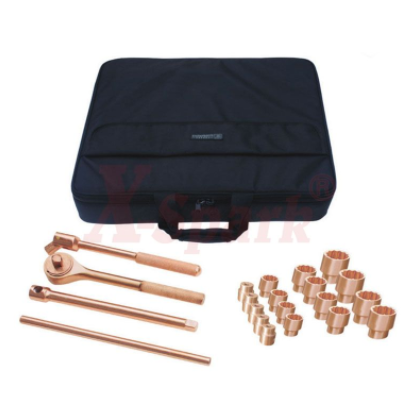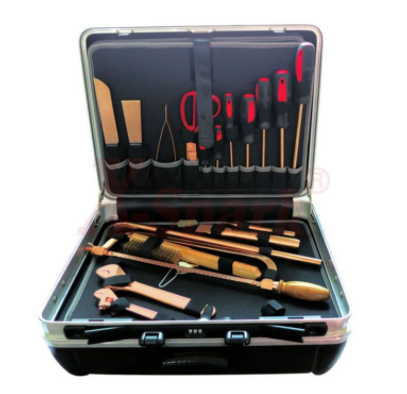What is a “non-sparking” tool?
“Non-sparking”, “spark reduced”, “spark-resistant” or “spark-proof” tools are names given to tools made of metals such as brass, bronze, Monel metal (copper-nickel alloy), copper-aluminum alloys (aluminum bronze), or copper-beryllium alloys (beryllium bronze).
Commonly used hand tools are often manufactured of steel alloys. Preferred “non-sparking” metals have less tensile strength than steels usually used to make tools. A lower tensile strength means the metal has less strength or resistance to tearing apart when stretched under test conditions. It also means that these non-sparking tools are softer, wear down more quickly than ordinary steel tools, and have to be dressed more frequently.
What is the non-sparking tool made of?
Non-sparking tools are made of materials that do not contain iron (non-ferrous metals) and therefore the risk of a spark being created while the tool is in use is reduced. Non-sparking tools protect against both fire and explosion in environments that may contain flammable liquids, vapors, dust, or residues. When working in confined spaces and areas where flammable gases or dust are present, using a non-sparking tool is the best practice.
Common materials used for non-sparking tools include brass, bronze, copper-nickel alloys, copper-aluminum alloys or copper-beryllium alloys. Beryllium alloys are less favorable due to the potential toxicity of beryllium dust. Non-metals such as wood, leather, and plastics can also be used to create non-sparking tools.
Some common tools that are available in a non-sparking option include hammers, axes, pry bars, chisels, utility knives, mallets, pliers, screwdrivers, sockets, and wrenches. Non-sparking polypropylene shovels are often used for hazardous material spill clean-up.
Because non-sparking tools are non-ferrous, they are softer than standard tools which are usually made of a high strength alloy steel. This may cause non-sparking tools to wear more quickly than their steel counterparts.
What is the most important thing to know about “non-sparking” tools?
Non-sparking tools also generate sparks sometimes referred to as “cold sparks”. These cold sparks have a low heat level and do not ignite carbon disulfide, which has the lowest ignition point of any substance known to man. Therefore while “non-sparking” tools may lower the risk of a spark, they do not eliminate the possibility of sparks. The name “non-sparking” is misleading because these tools are capable of producing a spark: the term “reduced-sparking tools” better describes these tools.
Non-metals like wood, leather, and plastic are suitable for some tools like shovels, scrapers or scoops and do not pose a friction spark hazard.
Non-sparking tools provide protection against fires and explosions in environments where there is a concern about sparks igniting flammable solvents, vapors, liquids, dust, or residues.
NOTE: It is important to assess each situation carefully and use the appropriate tools for the hazards that are present. In some cases, “non-sparking” tools may still be able to produce a spark. Contact the tool manufacturer and the producer of the flammable material (for example) for recommendations and more information.
NOTE: It is also important to consider the metals used in the tools themselves. For example, beryllium has been associated with several health issues including cancer. While exposure to beryllium dust is likely very low with the general use of non-sparking tools, it may be a consideration grinding or polishing the tool itself.
What are the hazards of both “sparking” and “non-sparking” tools?
Both “sparking” and “non-sparking” materials can cause ignition. Two types of hazards are associated with tools manufactured of either material:
Ignition by friction, with impact on each other or on other materials such as steel or concrete, in which an “ordinary” (mechanical or frictional) spark is generated. All tools can ignite flammable mixtures by sparks generated by friction or impact. However, this is true only when the generated spark is incendive: that means a spark that has to have enough heat content (i.e., enough mass and sufficiently high temperature) and has to last long enough to heat a flammable air-vapour mixture above its ignition temperature. This is more likely in the case of sparks formed when using a metal grinder than a spark generated when a hammer strikes some metal.
Ignition by a chemically-generated spark, caused by impact between certain metals and some oxygen-containing substances (such as rust, which is iron oxide).
How should you use and maintain “non-sparking” tools?
Follow the guidelines below to reduce the risk of explosion and fire.
Make sure all “non-sparking” tools are kept clean and free from ferrous or other contaminants, which may hamper the non-sparking properties.
Select the right sized tool for the task (such as the wrench opening to the nut). The right fit will help prevent the tool from slipping, reducing the chance of a spark.
Do not use non-sparking hand tools in direct contact with acetylene, which may form explosive acetylides, especially in the presence of moisture.
Use local or mechanical ventilation systems as appropriate to remove hazardous materials, dust, and vapors from the workplace.
Non-sparking tools will need to be redressed more often. Follow normal safety procedures when sharpening non-sparking tools such as the provision of eye and face protection, adequate extraction and dust collection facilities.
What is the best safeguard against incidental explosions?
Follow safe work procedures. Always evaluate a job to be done in any hazardous environment. Use proper tools and equipment that eliminate ignition such as electric motors that can be certified as “explosion-proof” for use in most hazardous work locations or non-sparking tools with proper use and maintenance. Keep in mind that there are no truly non-sparking tools. In any work where flames are used, or sparks are produced, make sure that an explosive atmosphere does not develop. Such atmospheres include flammable vapour-air mixtures and organic dust clouds like flour or coal dust. Isolation, ventilation and purging are methods of ensuring a safe working atmosphere. Use explosimeters in the workplace to protect those working in hazardous environments.
Commonly Asked Questions
Q: How do I store and maintain my non-sparking tools?
A: Keep non-sparking tools clean and free of ferrous metal contamination which can reduce their non-sparking ability. Avoid contact with acetylene which can form explosive acetylides, especially in the presence of moisture. If damage has occurred to the striking face of hammers or to the edge of chisels, the tools should have the faces and heads redressed. Do not store hammers and other hand tools fitted with wooden handles in places where the handles may dry out and shrink. This will increase the risk of the handle breaking or the head becoming loose.
Q: Why does a non-sparking tool specify that it is beryllium free?
A: The non-sparking tool industry is sensitive to the potential toxicity of beryllium dust, mist, and fumes that may occur while working with the softer metals in a non-sparking tool. Other non-sparking metals do not carry that same concern.
We are a non-sparking tools provider, please feel free to contact us if you need them!


评论
发表评论